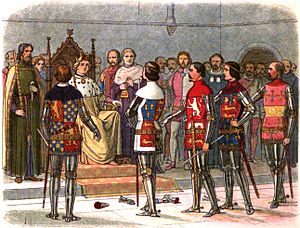Lords Appellant facts for kids

The Lords Appellant were a group of powerful noblemen in England during the time of King Richard II. In 1388, they wanted to challenge some of the King's closest friends. They believed these friends were leading the King to rule unfairly. The word appellant means someone who is 'appealing' or making a formal accusation. They used a special legal process called an 'appeal of treason' to accuse the King's friends of serious crimes against the country.
Contents
Who Were the Lords Appellant?
There were originally three main Lords Appellant. They were:
- Thomas of Woodstock, Duke of Gloucester: He was the son of King Edward III and the uncle of King Richard II.
- Richard FitzAlan, Earl of Arundel and of Surrey: A very important nobleman.
- Thomas de Beauchamp, Earl of Warwick: Another powerful earl.
Later, two more important noblemen joined their group:
- Henry Bolingbroke, Earl of Derby: He would later become King Henry IV.
- Thomas de Mowbray, Earl of Nottingham: Another significant earl.
What Did the Lords Appellant Achieve?
The Lords Appellant were very successful in their goals.
Taking Control of England
First, they set up a special group called a Commission. This group was given the power to govern England for one year, starting in November 1386. This meant King Richard had less real power.
The Battle of Radcot Bridge
In 1387, the Lords Appellant started an armed rebellion against King Richard. Their army fought against an army led by Robert de Vere, Earl of Oxford, one of the King's favourites. This fight happened at Radcot Bridge, near Oxford. The Lords Appellant won this battle. After their victory, King Richard remained king, but he had very little actual power.
Punishing the King's Friends
The Lords Appellant took action against the King's friends in a special meeting of Parliament in 1388. This meeting is often called the "Merciless Parliament" because it was very strict.
- Robert de Vere and Michael de la Pole, Earl of Suffolk had run away from England. They were sentenced to death even though they were not there.
- Alexander Neville, Archbishop of York, had all his belongings taken away.
- Other important people, like Sir Robert Tresilian (a chief judge) and Sir Nicholas Brembre (the Lord Mayor of London), were executed.
- Sir Simon Burley was also found guilty of having too much influence over the King. He was executed even though some people, including Henry Bolingbroke, tried to save him.
What Happened Next?
King Richard Regains Power
In 1389, King Richard's uncle, John of Gaunt, came back to England from Spain. With his help, King Richard slowly started to get his power back. By 1397, he was strong enough to challenge the Lords Appellant.
The Fate of the Lords Appellant
King Richard never forgot what the Lords Appellant had done to him.
- His uncle, Gloucester, was killed while being held prisoner. Many people believed King Richard ordered his death.
- The Earl of Arundel was executed.
- Warwick lost his title and his lands. He was sent to prison on the Isle of Man. He stayed there until King Richard was removed from power.
Bolingbroke and Mowbray
The two younger Lords Appellant, Henry Bolingbroke and Thomas Mowbray, also faced problems. In 1398, King Richard sent both of them away from England. He also took away their right to inherit any family wealth. This was especially important for Bolingbroke, whose father, John of Gaunt, was very rich.
Richard's Downfall
In 1399, King Richard II was removed from power by Henry Bolingbroke. This happened partly because Richard had taken all of John of Gaunt's wealth when he died. Bolingbroke then became the new king, known as Henry IV.

